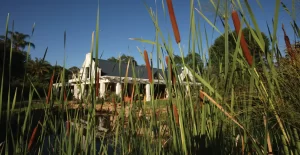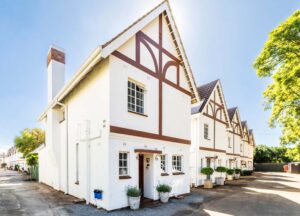Imagine the delight of spending time in a garden immersed in a timeless natural landscape that produces a sense of peace, refuge and of feeling oneself within nature’s embrace.
A garden that:
• Attracts birdlife, bees, butterflies and other insects and small animals;
• Uses water-wise indigenous plants;
• Forms new habitats to increase species bio-diversity;
• Transforms an existing swimming pool into a natural looking eco-pool and
• Recycles rain harvested water.
Jan and Fiona Teede have always been avid naturalists with a deep interest in all things wild and wonderful. When they moved into a home with five acres of established gardens, they decided to change it into an environmentally friendly landscape. They engaged Tore Ballance, a Landscape Designer, and worked with him to create a garden which would fulfill the above criteria.
Tore’s sketch below shows how the existing swimming pool could be incorporated into a much bigger and more natural looking water feature comprising falls, pools, rapids and a stream. This was the starting point and from that nucleus, the whole landscape emanated. The Teede’s liked the concept and work began.
The Architect, Bruce Rowlands, designed the house so that all the rainwater from the roof (the highest point of the property) could be harvested. This water is now piped into the main water feature and any excess is channeled down into the water storage dam, which is at the lowest point of the property. The key to the success of a natural landscape design is to be sensitive to connecting the water from all the created catchment zones, so that it naturally drains towards the water storage area. In this way, no rain water should leave the property and there is no flooding, as was the case when the garden was a flat landscape. The water held in the water storage dam is used later on during the dry season. All the material for creating the undulating landscape came from within the property and also incorporated the building rubble. The main water feature is the highest point in the landscape rising to three metres. From here the water tumbles over a waterfall into a large rocky pool and then winds its way down through rapids and ponds into a large pool. In the design stage even the music of the different water sounds was considered: there is the pounding of the waterfall, the gentle flow of the stream and the swish and swirl as it goes over rapids and spills into ponds.
DESIGN IMPLEMENTATION
Some eight months, following the build, one enters the redesigned garden through an African meadow which will be ever-changing with flowering grasses and tangled bright wild flowers. As the seasons progress it will be a delight to see what new indigenous species will pop up here and throughout the garden.
At the entrance to the house is a waterfall and pool which lead into a garden courtyard. The African meadow at the entrance to the house comprising a diverse mix of local grasses and plants Figure 3:
Entrance to the garden courtyard Two of the main bedrooms open out into a patch of English garden where the beds are full of lavender, camellias, daisies and buddleja. Outside the kitchen there is a raised vegetable garden where a variety of vegetables and fruits are planted in rotation. Bright marigolds add colour, deter pests and are also reputed to give added strength to plants such as basil, broccoli and tomatoes.
Sprawling nasturtiums intermingle. The sides are a sloping rockery and pockets of soil produce a wide variety of herbs and other produce. No pesticides are applied. The old swimming pool is unrecognizable: it has been transformed into a majestic waterfall tumbling over granite into a natural rocky pool.
The water flows through rapids and ponds into a large pool. The large pool Three species of indigenous bream have been introduced into the pool: Oreochromis niloticus, Tilapia rendalli, and Tilapia sparrmanii.
A few barbel and some mountain catfish are also represented, as are a number of species of frogs and snails. The fish gobble up any mosquito larvae that hatch, so the Teede’s can sleep peacefully, without need of a mosquito net. Associated vegetation in and around the pools and stream, such as water lilies, water lettuce, wild irises, arum lilies, bull rushes, Cyperus papyrus and red hot pokers, make this look like a totally natural and un-spoilt stream scene.
The sounds of flowing water and the shimmering reflections take one far away from suburban Harare and into a wild and tranquil place. Birds flit in and out of the shadows by the water, in the woodlands and shrubs, and the garden is alive with their activity and calls. A Domboshava theme was incorporated into several small pockets of the garden and representative species were brought in. These include resurrection plants, Aloe chabaudii and Aloe cameronii, wild ginger, firebush, the Roman Candle, sedges and grasses. As one goes down towards the water storage dam, one passes through wetland, hot and dry patches, rocky mounds and low areas. Throughout the rocks with lime green, orange and grey lichen, form wonderful patterns and shifting shadows. The basic principles of exotic gardening have developed over the centuries, and obviously many of these stand true for the indigenous garden: structure, design, a variety of textures, sensitivity to colour, and so on.
THE CREATION OF NATURAL LANDSCAPES
In order to design and create a garden like this an understanding of natural landscapes is important. To increase a sense of greater space, one decreases the dominance of wide open spaces. To increase diversity of species once must increase the diversity of habitats. Like a painting, all parts must connect with each other and be artistically balanced. Thus, all the new catchments and drainage lines form patterns and the overall picture is one of an unending landscape. There are natural curves and patterns and no straight lines or borders. The choice of which species to plant in is an important detail and variations must include the objectives of the client. In this case it was important to increase the diversity of birds and insects and so all the different habitats are dominated by appropriate grasses, shrubs and plants. The following photograph shows the importance of sensitive rock placing that allows for a granite water feature to look natural. The indigenous plants are all correctly placed and provide the interface for harmoniously pulling all the elements and sense of flow together.
However, in order to make an indigenous landscape, there had to be a paradigm shift away from the culture and design of the urban exotic garden. The dominance of large shady trees gives way to a diversity of smaller trees and shrubs. The canopy reduces from 8-20 meters to 3-5 meters. A greater variety of landscapes replaces lawns and flowerbeds. In this particular landscape The creation of an indigenous landscape in the middle of urban exotica is a major challenge. It is as though one is a pioneer in a land of exotics and the battle is to re-establish and celebrate our own indigenous vegetation. Regular maintenance will remove any exotics that try to invade. The majority of exotic trees and shrubs in the property were removed and over a thousand trees, shrubs and plants, comprising over a hundred different species, were brought in. It is not always easy to find a wide variety of indigenous plants in local nurseries, but a good selection was found at Emerald Seedlings, Bushy Landscapes in Harare and Huntsman Indigenous Trees in Bulawayo.
A WATER-WISE INDIGENOUS GARDEN
The design has been successful in increasing bird life: three hammerkops, a grey heron, a purple heron and a pied kingfisher are regular visitors to the ponds, where the fish breed prolifically, providing a cornucopia for fish eating birds. Banks are being constructed for kingfisher nests and tree-hole nesting species such as barbets are being provided with accommodation. Different habitats appeal to different species, and the team has tried to provide suitable homes for as many different birds as possible. Insects, spiders, and other arthropods are allowed to multiply unhindered, providing food for the insectivorous birds, and a dizzying array of ladybirds consume the aphids. The introduction of a variety of grasses, such there are now watersheds, drainage lines, scalloped zones, rocky habitats, sand habitats, compacted zones, thickets, wetland and running water. There is even diversity in even in the water flow, with areas of deep water, shallow water, rocky pools and stream beds, pebbles, muddy water, still pools, pounding water and areas of fast and slow flow as Panicum, Setaria, Eriochloa, Sporobolus and Eragrostis attracts seed eaters. Every morning a clump of Panicum maximum in the front garden is a-quiver with Bronze manikins and other seed eaters. Together the Teede’s and Tore have conceived a garden of natural elegance, which compliments the graceful, modern Cape Dutch design of the house.
The landscape is dynamic, exciting and ever changing and more importantly one that is water-wise, with new habitats and increased biodiversity. The sense of wilderness pervades and this is a garden where one is calmed and can escape and restore. Every detail has been thought through and the effect has been to create an intricate painting with many different facets, but which all connect and flow together and showcase the freshness and purity of nature at its best.
Landscape designer’s email address: tore.ballance@gmail.com









